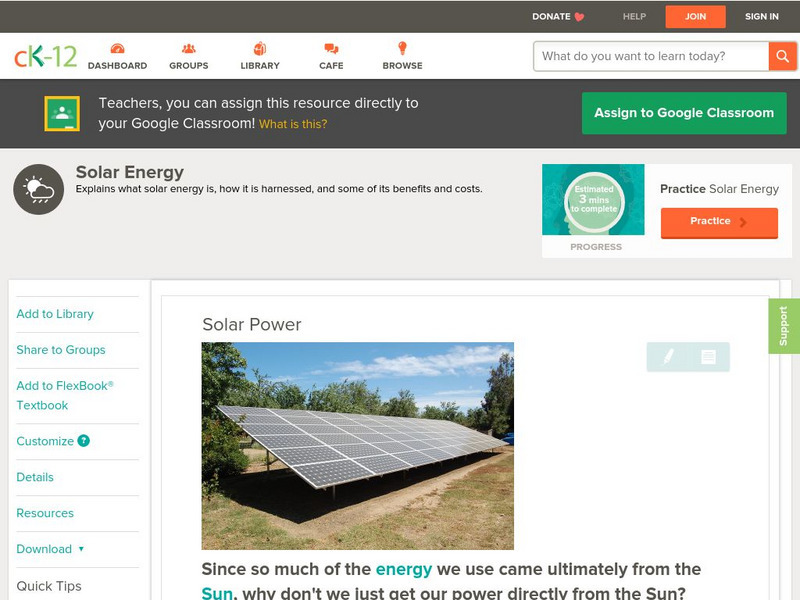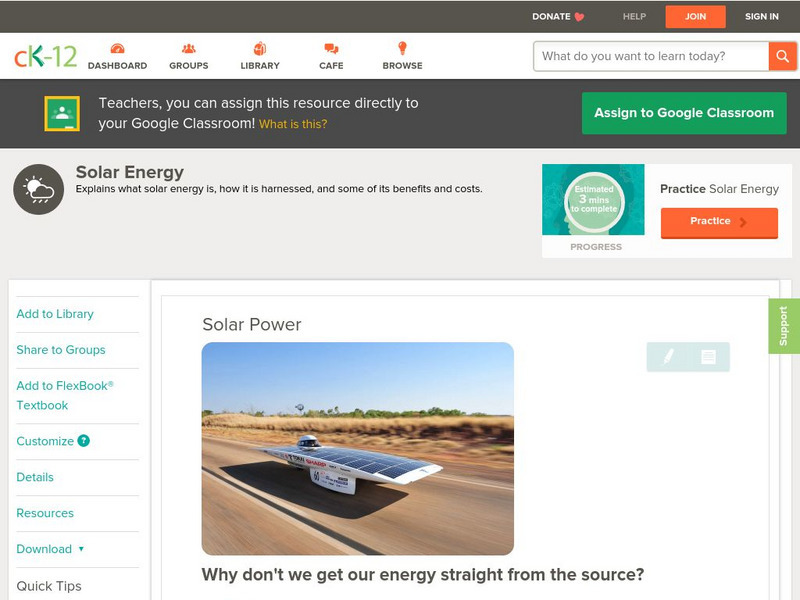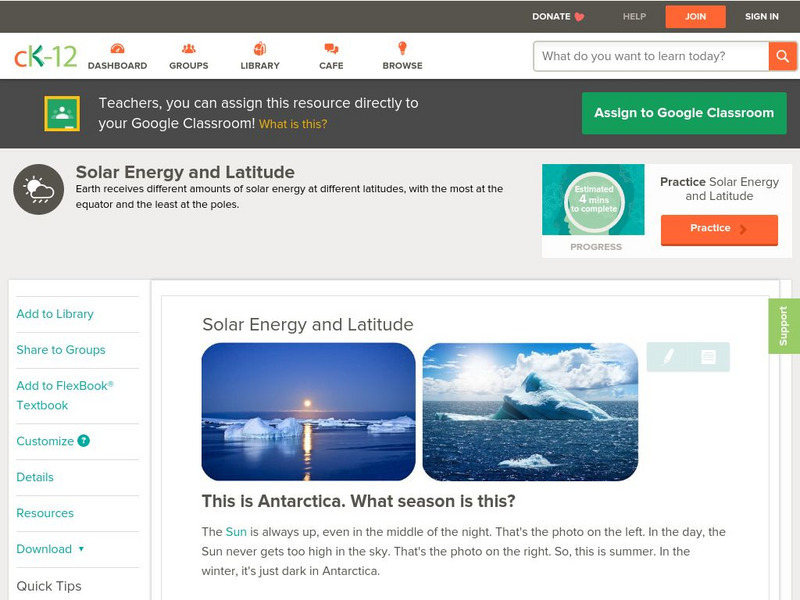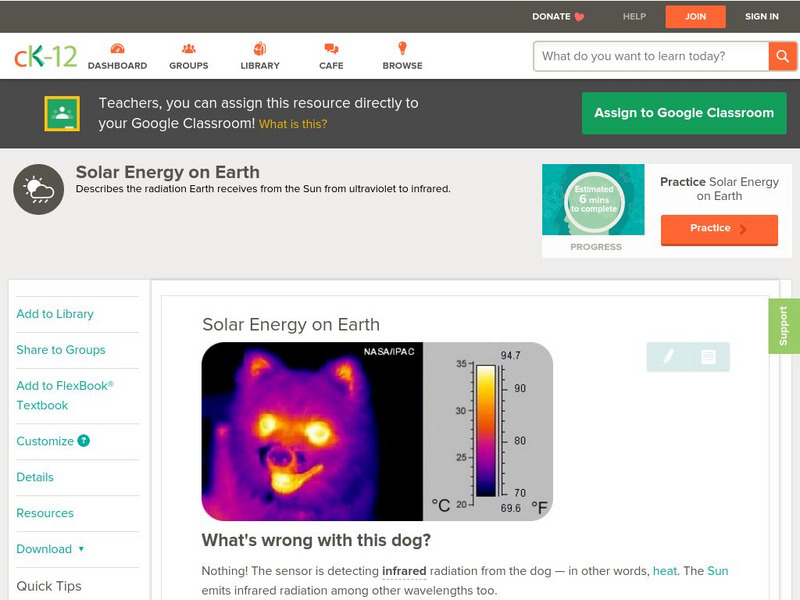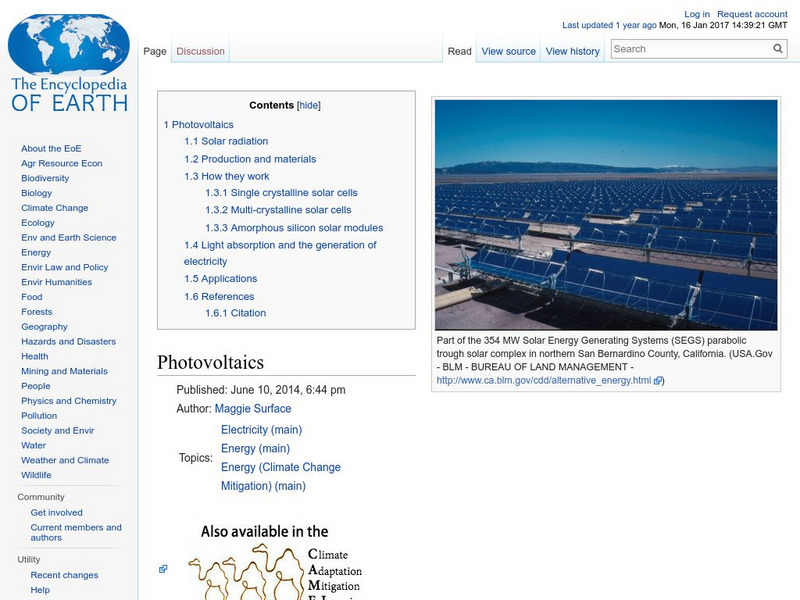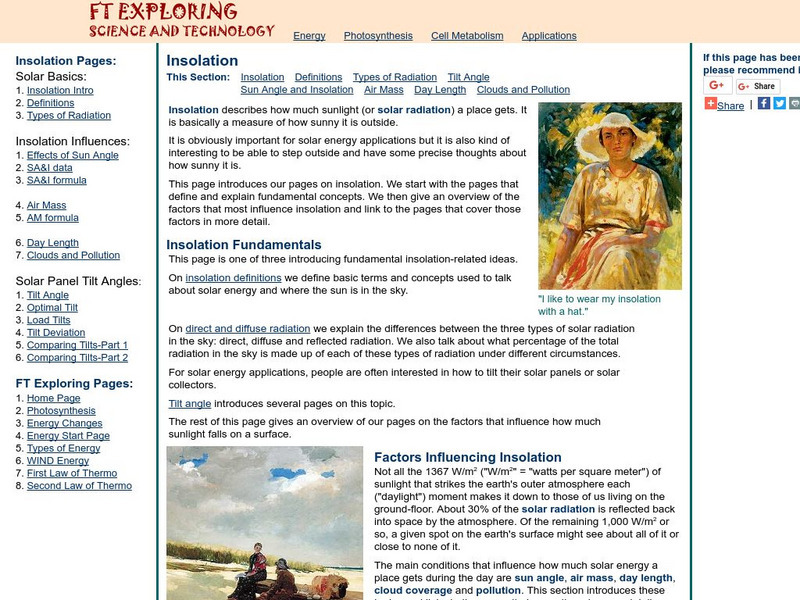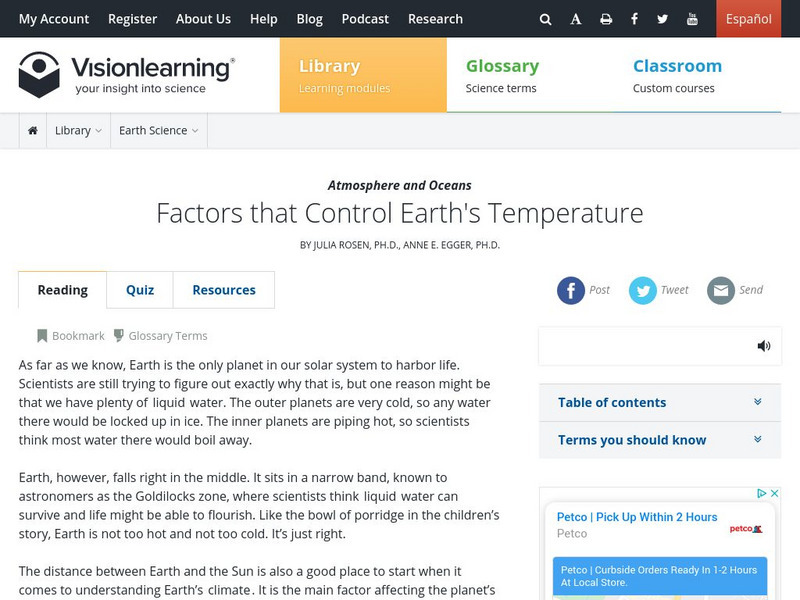Hi, what do you want to do?
Curated OER
Meteorology Word Search Puzzle
In this science worksheet, students look for the words that are related to the theme of the worksheet. They also work on the skills of spelling and word recognition.
Curated OER
Cloud Forecast
Students record weather observations and research online weather data. In this weather observations lesson, students study the cloud cover for several days and record their observations in a chart. Students identify the cloud types and...
Curated OER
Persistence Forecasting
Students study weather forecasting. In this weather lesson, students explore forecasting weather methods and do a forecast. Students study weather reports and discuss the elements of a forecast. Students study the method of persistence...
Encyclopedia of Earth
Encyclopedia of Earth: Energy: Solar Power
Explains what solar power is, how it is produced, its limitations as an alternative energy source, environmental issues, the importance of analyzing solar power systems on an ongoing basis, and geographical considerations. (Published:...
Other
Massachusetts Department of Education: Sunlight Warms Earth's Surface
This unit contains a series of lessons that allow young scholars to explore the effect of sunlight on Earth's natural surfaces of sand, soil, rock, and water. In addition, students explore how the color and material of a surface affects...
TeachEngineering
Teach Engineering: Solar Power
Students learn about solar energy and how to calculate the amount of solar energy available at a given location and time of day on Earth. The importance of determining incoming solar energy for solar devices is discussed.
CK-12 Foundation
Ck 12: Earth Science: Solar Energy on Earth
[Free Registration/Login may be required to access all resource tools.] Describes characteristics of solar energy including the electromagnetic spectrum and movement.
CK-12 Foundation
Ck 12: Earth Science: Solar Power
[Free Registration/Login may be required to access all resource tools.] How solar energy can be used and its consequences.
CK-12 Foundation
Ck 12: Earth Science: Solar Power
[Free Registration/Login may be required to access all resource tools.] How solar energy can be collected and used, and the consequences of it.
CK-12 Foundation
Ck 12: Earth Science: Solar Energy and Latitude
[Free Registration/Login may be required to access all resource tools.] Discusses the relationship between solar energy and latitude.
Encyclopedia of Earth
Encyclopedia of Earth: Solar Radiation
Almost all of the energy that drives the various systems (climate systems, ecosystems, hydrologic systems, etc.) found on the Earth originates from the sun. Solar energy is created at the core of the sun when hydrogen atoms are fused...
PBS
Pbs Learning Media: Link Between Arctic Sea Ice and Solar Radiation Absorbed
The Arctic plays an important role in regulating Earth's climate. The region reflects much of the Sun's energy and helps keep the planet cool. Data collected by NASA have revealed that sea ice in the Arctic has steadily declined over the...
CK-12 Foundation
Ck 12: Earth Science: Solar Energy on Earth
[Free Registration/Login may be required to access all resource tools.] A breakdown of the types of energy that Earth receives from the sun.
American Geosciences Institute
American Geosciences Institute: Energy
Seven hands-on lessons module where students learn about energy. These inquiry-based explorations investigate where energy resources come from and how they are converted into electricity, how fossil fuels form, the importance of...
University Corporation for Atmospheric Research
Ucar: Cycles of the Earth System: Earth's Energy Cycle: Albedo
Students experiment and observe how the color of materials that cover the Earth affects the amounts of sunlight our planet absorbs.
Encyclopedia of Earth
Encyclopedia of Earth: Photovoltaics
Article explaining what photovoltaic cells are, their role in solar energy, how they work, how electricity is produced, and applications of this technology. (Published: April 24, 2010)
CK-12 Foundation
Ck 12: Earth Science: Solar Power Study Guide
[Free Registration/Login may be required to access all resource tools.] This study guide summarizes key points about solar energy, how it is harnessed, and its benefits and disadvantages. Includes a few questions to check for understanding.
FT Exploring
Ft Exploring: Insolation and Solar Availability
Learn about insolation, or how much sunlight or solar radiation any given place on Earth receives based on many factors.
TED Talks
Ted: Ted Ed: Sunlight Is Way Older Than You Think
It takes light a zippy eight minutes to reach Earth from the surface of the Sun. But how long does it take that same light to travel from the Sun's core to its surface? Oddly enough, the answer is many thousands of years. Sten Odenwald...
Alabama Learning Exchange
Alex: Understanding Solar Energy. Part 1
This lesson discusses how electromagnetic radiation transfer the sun's energy to earth. This lesson will also talk about the eight types of electromagnetic waves in the electromagnetic spectrum and how each type is used or found in our...
CK-12 Foundation
Ck 12: Earth Science: Solar Energy on Earth Study Guide
[Free Registration/Login may be required to access all resource tools.] This study guide summarizes key points about the energy we receive from the Sun. Includes a few questions to check for understanding.
Other
Newport: Introduction to Solar Radiation
Radiation from the sun sustains life on earth and determines climate. The energy flow within the sun results in a surface temperature of around 5800 K, so the spectrum of the radiation from the sun is similar to that of a 5800 K...
Vision Learning
Visionlearning: Atmosphere and Oceans: Factors That Control Earth's Temperature
An explanation of how temperature is affected by the composition of the atmosphere and how energy flows in and out of Earth's atmosphere.
TED Talks
Ted: Ted Ed: How Do Solar Panels Work?
The Earth intercepts a lot of solar power: 173,000 terawatts. That's 10,000 times more power than the planet's population uses. So is it possible that one day the world could be completely reliant on solar energy? Richard Komp examines...












